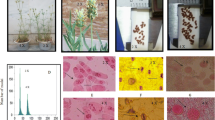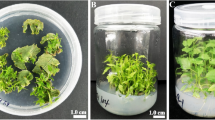Abstract
Dendrobium cariniferum Rchb. f. is an important crossing parent that is primarily used to produce aromatic Dendrobium orchid cultivars due to its beautiful flowers and pleasant orange fragrance. However, there are no offspring within the limited progenies that fully inherit this odor trait. Thus, converting diploid D. cariniferum into tetraploids for interploid hybridization is another promising approach to creating a new orange aroma germplasm. This study reports a novel in vitro colchicine-induced chromosome doubling protocol that would effectively convert diploid D. cariniferum protocorms into tetraploids. A total of 120 tetraploid genotypes were identified by flow cytometry. The tetraploid induction rate was significantly affected by interaction between the colchicine concentration and exposure time. Treatment with 0.05% colchicine for 24 h produced the optimal results, yielding 54% surviving regenerated plantlets with a 33% tetraploid induction rate. The tetraploid plantlets displayed obvious morphological variations (broader, thicker leaves and greater stem and root diameters) than the diploid plantlets. Tetraploidization also caused a significant change in the leaf anatomical structure, including larger stomata with lower densities, more chloroplasts per stomata, thicker spongy tissues, larger leaf veins and decreased adaxial epidermal cell and trichome densities. We were the first to observe that there are one to five branched trichomes in the leaf sheath in both diploids and tetraploids, and we propose that the leaf adaxial epidermal cell density can be used to identify tetraploids. Moreover, tetraploids exhibited a 1.75-fold greater genome size than diploids. Our study lays the foundation for breeding triploid aromatic Dendrobium orchids.
Key message
Autotetraploidy causes morphological, anatomical and genome size variations. This is the first report of trichome types in the leaf sheath. Leaf adaxial epidermal cell density is useful for identifying tetraploids.







Similar content being viewed by others
References
Adams WW, Terashima I (2018) The leaf: a platform for performing photosynthesis. Springer International Publishing, Cham
Anssour S, Krügel T, Sharbel TF, Saluz HP, Bonaventure G, Baldwin IT (2009) Phenotypic, genetic and genomic consequences of natural and synthetic polyploidization of Nicotiana attenuata and Nicotiana obtusifolia. Ann Bot 103:1207–1217
Bill L, Wayne H, Geoff S (2000) Dendrobium and its relatives. Timber Press, Portland
Chen WH, Chen HH (2011) Orchid biotechnology II. World Scientific Publishing, Singapore
Choopeng S, Te-chato S, Khawnium T (2019) Effect of colchicine on survival rate and ploidy level of hydrid between Dendrobium santana × D. friedericksianum orchid. Int J Agric Technol 15:249–260
Chung MY, Kim CY, Min JS, Lee DJ, Naing AH, Chung JD, Kim CK (2014) In vitro induction of tetraploids in an interspecific hybrid of Calanthe (Calanthe discolor × Calanthe sieboldii) through colchicine and oryzalin treatments. Plant Biotechnol Rep 8:251–257
Dhooghe E, Van Laere K, Eeckhaut T, Leus L, Van Huylenbroeck J (2011) Mitotic chromosome doubling of plant tissues in vitro. Plant Cell Tissue Organ Cult 104:359–373
Doležel J, Bartoš JAN (2005) Plant DNA flow cytometry and estimation of nuclear genome size. Ann Bot 95:99–110
Doležel J, Sgorbati S, Lucretti S (1992) Comparison of three DNA fluorochromes for flow cytometric estimation of nuclear DNA content in plants. Physiol Plant 85:625–631
Eng WH, Ho WS (2019) Polyploidization using colchine in horticultural plants: a review. Sci Hortic 246:604–617
Gantait S, Mandal N, Bhattacharyya S, Das PK (2011) Induction and identification of tetraploids using in vitro colchicine treatment of Gerbera jamesonii Bolus cv. Sciella. Plant Cell Tissue Organ Cult 106:485
Gomes SSL, Saldanha CW, Neves CS, Trevizani M, Raposo NRB, Notini MM, Santos MDO, Campos JMS, Otoni WC, Viccini LF (2014) Karyotype, genome size, and in vitro chromosome doubling of Pfaffia glomerata (Spreng.) Pedersen. Plant Cell Tissue Organ Cult 118:45–56
Gross K, Schiestl FP (2015) Are tetraploids more successful? floral signals, reproductive success and floral isolation in mixed-ploidy populations of a terrestrial orchid. Ann Bot 115:263–273
Grosso V, Farina A, Giorgi D, Nardi L, Diretto G, Lucretti S (2018) A high-throughput flow cytometry system for early screening of in vitro made polyploids in Dendrobium hybrids. Plant Cell Tissue Organ Cult 132:57–70
He M, Gao WJ, Gao YH, Liu YZ, Yang X, Jiao HB, Zhou YW (2016) Polyploidy induced by colchicine in Dendranthema indicum var. aromaticum, a scented chrysanthemum. Eur J Hortic Sci 81:219–226
Huchelmann A, Boutry M, Hachez C (2017) Plant glandular trichomes: natural cell factories of high biotechnological interest. Plant Physiol 175:6–22
Jones K, Lim KY, Cribb PJ (1982) The chromosomes of orchids VII Dendrobium. Kew Bull 37:221–227
Kondo H, Phlaetita W, Mii M, Kikuchi S, Deguchi A, Miyoshi K (2020) Efficient chromosome doubling of an interspecific hybrid Dendrobium stardust ‘fire bird’ by treatment of amiprofos-methyl to protocorm-like body. In Vitro Cell Dev Biol-Plant 1–12
Lattier JD, Chen H, Contreras RN (2019) Variation in genome size, ploidy, stomata, and rDNA signals in Althea. J Am Soc Hortic Sci 144:130–140
Leitch IJ, Bennett MD (2004) Genome downsizing in polyploidy plants. Biol J Linnean Soc 82:651–663
Liu WT, Song SY, Li DL, Lu XC, Liu JR, Zhang JW, Wang J (2020) Isolation of diploid and tetraploid cytotypes from mixoploids based on adventitious bud regeneration in Populus. Plant Cell Tissue Organ Cult 140:1–10
Liu WT, Zheng YF, Song SY, Huo BB, Li DL, Wang J (2018) In vitro induction of allohexaploid and resulting phenotypic variation in Populus. Plant Cell Tissue Organ Cult 134:183–192
Nakasone HY (1960) Artificial induction of polyploidy in orchids by the use of colchicines. PhD thesis, University of Hawaii, USA
Pham PL, Li YX, Guo HR, Zeng RZ, Xie L, Zhang ZS (2019) Changes in morphological characteristics, regeneration ability, and polysaccharide content in tetraploid Dendrobium officinale. HortScience 54:1879–1886
Podwyszyńska M, Gabryszewska E, Dyki B, Stepowska A, Kowalski A, Jasiński A (2015) Phenotypic and genome size changes (variation) in synthetic tetraploids of daylily (Hemerocallis) in relation to their diploid counterparts. Euphytica 203:1–16
Sarathum S, Hegele M, Tantiviwat S, Nanakorn M (2010) Effect of concentration and duration of colchicine treatment on polyploidy induction in Dendrobium scabrilingue L. Eur J Hortic Sci 75:123–127
Sattler MC, Carvalho CR, Clarindo WR (2016) The polyploidy and its key role in plant breeding. Planta 243:281–296
Tang K, Yang S, Feng XX, Wu T, Leng JT, Zhou HK, Zhang YH, Yu H, Gao JJ, Ma JJ, Feng XZ (2020) GmNAP1 is essential for trichome and leaf epidermal cell development in soybean. Plant Mol Biol 103:609–621
Tantasawat P, Khairum A, Chaowiset W, Wannajindaporn A (2012) Pronamide-induced polyploidy in Rhynchostylis and Dendrobium. Acta Hortic 937:615–620
Tian J, Han LB, Feng ZD, Wang GD, Liu WW, Ma YP, Yu YJ, Kong ZS (2015) Orchestration of microtubules and the actin cytoskeleton in trichome cell shape determination by a plant-unique kinesin. Elife 4:e09351
Trávníček P, Ponert J, Urfus T, Jersáková J, Vrána J, Hřibová E, Doležel J, Suda J (2015) Challenges of flow-cytometric estimation of nuclear genome size in orchids, a plant group with both whole-genome and progressively partial endoreplication. Cytom Part A 87:958–966
Wang LJ, Zhang Q, Cao QZ, Gao X, Jia GX (2020) An efficient method for inducing multiple genotypes of tetraploids Lilium rosthornii Diels. Plant Cell Tissue Organ Cult 141:499–510
Wang Y, Zhou JC, Zheng BQ, Chen ZH, Huang ZH (2014) Dendrobium. China Forestry Publishing House, Beijing (in Chinese)
Wannajindaporn A, Kativat C, Tantasawat PA (2016) Mutation induction of Dendrobium ‘Earsakul’ using sodium azide. HortScience 51:1363–1370
Xu Q, Zhang GQ, Liu ZJ, Luo YB (2014) Two new species of Dendrobium (Orchidaceae: Epidendroideae) from China: evidence from morphology and DNA. Phytotaxa 174:129–143
Yenchon S, Te-chato S (2012) Polyploidy induction of Dendrobium formosum by colchicine treatment in vitro. Acta Hort 1025:81–88
Younis A, Hwang YJ, Lim KB (2014) Exploitation of induced 2n-gametes for plant breeding. Plant Cell Rep 33:215–223
Zeng RZ, Zhu J, Xu SY, Du GH, Guo HR, Chen JJ, Zhang ZS, Xie L (2020) Unreduced male gamete formation in Cymbidium and its use for developing sexual polyploid cultivars. Front Plant Sci 11:558
Zhang XQ, Gao JY (2020) In vitro tetraploid induction from multigenotype protocorms and tetraploid regeneration in Dendrobium officinale. Plant Cell Tissue Organ Cult 141:289–298
Acknowledgements
We thank Professor Jaroslav Doležel for the kind supply of internal standard germplasm. This work was supported by the National Natural Science Foundation of China (U1702235) and the Ministry and Province Joint Construction Project of Yunnan University (C176280109).
Author information
Authors and Affiliations
Contributions
JYG and XQZ conceived and designed the experiments; XQZ performed the experiments; XQZ analyzed the data and wrote the manuscript; and XQZ and JYG revised the manuscript. All the authors read and approved the final manuscript.
Corresponding author
Ethics declarations
Conflict of interest
The authors declare that they have no conflicts of interest.
Additional information
Communicated by Jose M. Segui-Simarro.
Publisher's Note
Springer Nature remains neutral with regard to jurisdictional claims in published maps and institutional affiliations.
Rights and permissions
About this article
Cite this article
Zhang, X., Gao, J. Colchicine-induced tetraploidy in Dendrobium cariniferum and its effect on plantlet morphology, anatomy and genome size. Plant Cell Tiss Organ Cult 144, 409–420 (2021). https://doi.org/10.1007/s11240-020-01966-4
Received:
Accepted:
Published:
Issue Date:
DOI: https://doi.org/10.1007/s11240-020-01966-4




